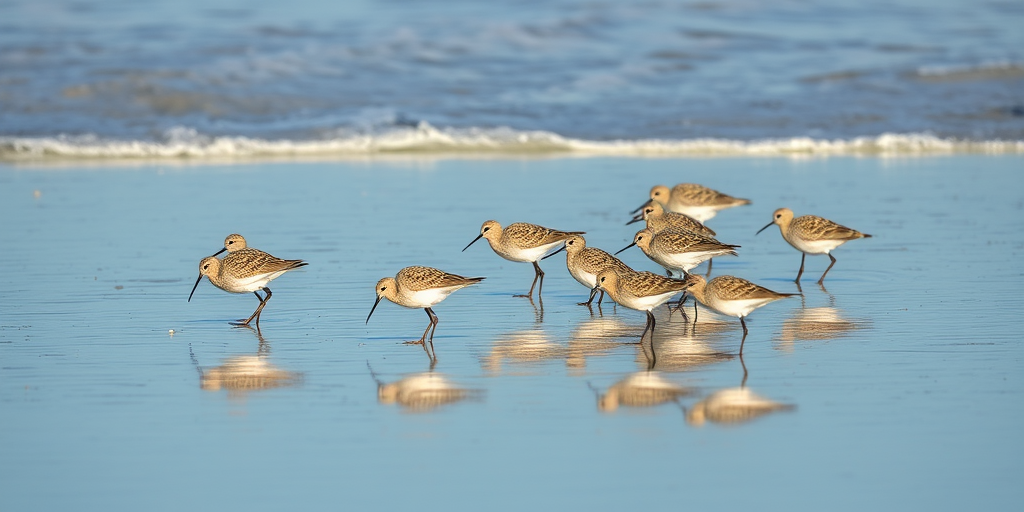Are shorebirds skilled operatives executing covert missions at high tide? Recent field studies reveal shorebirds engaging in precise foraging behaviors rarely seen beyond familiar coastal edges. Observations of species executing tactical feeding maneuvers mirror operations that demand refined coordination and exact timing. This narrative examines behavioral nuances and strategic movements, drawing parallels with coordinated military logistics. The post presents an analysis of these dynamic patterns, challenging conventional perceptions of coastal avian life by exposing complex survival tactics performed far away from the beach.
Operational Behaviors: Hidden Shorebird Tactics Beyond the Beach
Shorebirds exhibit behaviors that mirror military operations in their feeding and survival maneuvers. Instead of simply foraging on the surface, these birds perform highly specialized feeding on horseshoe crab eggs requiring precision. Their foraging technique is refined to counter environmental variables and maximize energy intake during optimal tidal windows. Each species implements tactical adjustments that allow them to engage in coordinated strikes where timing and positioning are critical in the ever-changing coastal environment.
As light fades and tides shift, stealthy routines emerge beneath the oceanfront habitat’s façade. In low-light conditions, shorebirds initiate secret foraging operations designed to reduce exposure to predators while securing essential resources. Individual species execute subtle, premeditated movements that parallel covert tactical maneuvers. These actions depend on acute environmental cues and split-second decision-making, forming a disciplined framework that governs their behavior. The following tactical steps outline the core of their operational strategy:
- Strategic positioning during low tide
- Coordinated flock movements
- Rapid response to environmental changes
- Precise resource targeting
These coordinated actions showcase an interplay of instinct and environmental awareness. Shorebirds adapt their movement patterns dynamically as tides alter resource availability, shifting formation in response to sudden changes. Their precise maneuvers result in a managed process of resource acquisition that secures their survival in competitive intertidal zones. Each tactical deployment reflects an exceptional ability to interpret contextual cues, echoing military precision and revealing a hidden aspect of their secret life far beyond the typical beach scene.
Field Operations and Conservation: Protecting Shorebird Habitats Beyond the Beach

In North America, studies indicate a significant decline in bird numbers since the 1970s, with red knot populations experiencing dramatic reductions. Factors such as habitat loss, coastal erosion, and human disturbances from dogs and recreational activities mirror challenges faced in military defensive operations. Evaluating these impacts requires precise assessments, much like strategic intelligence gathering during field operations.
Conservation strategies mirror tactical measures found in defense planning. Researchers employ banding, annual counts, and GPS tracking to monitor and address these declines, with sites such as South Carolina’s DVO Bank receiving international protection. These methodologies provide a blueprint for mitigating urban encroachment and adapting to challenges posed by climate change, ensuring that shorebird habitats continue to support essential ecological functions.
- Implementing strict habitat preservation zones
- Enhancing monitoring through GPS tracking and banding
- Promoting international conservation collaborations
- Regulating coastal recreation to reduce disturbances
- Expanding protected areas to mitigate urban encroachment
This framework reflects an organized, military-like approach to conservation, wherein each action contributes to a broader defense strategy for natural territories. Tactical conservation operations not only address immediate threats but also lay the groundwork for sustainable habitat protection in the face of ongoing environmental challenges.
Final Words
In the action, the article compared tactical feeding and migration with methods similar to military operations.
The narrative detailed strategic flock movements, precise resource targeting, and proactive conservation measures.
Operational observations highlighted varied behavioral cues and community-driven ecological assessments.
The Secret Life of Shorebirds: Beyond the Beach illustrates a dynamic blend of scientific inquiry and devoted stewardship.
The discussion affirms that understanding these natural tactics can fuel optimism for preserving shorebird habitats, inspiring a forward-looking mindset in birdwatching and conservation efforts.
FAQ
Q: What defines a shorebird species?
A: Shorebirds are coastal and wetland birds characterized by long legs, specialized bills, and exceptional migratory abilities. These birds inhabit beaches, mudflats, and tidal areas.
Q: What is the typical migration distance for shorebirds?
A: Red knots demonstrate the most impressive migration, covering up to 20,000 miles annually between South America and Arctic breeding grounds, making strategic stops along coastal areas.
Q: What special adaptations do shorebirds possess?
A: Shorebirds have specialized bills for probing sand, long legs for wading, and efficient digestive systems. Their bodies are streamlined for long-distance flight and coastal survival.
Q: How do shorebirds find food during migration?
A: Shorebirds target high-energy food sources like horseshoe crab eggs during migration stops. They use precise foraging techniques and coordinate in groups during tidal changes.
Q: What conservation challenges do shorebirds face?
A: Shorebird populations have decreased by 70% since the 1970s due to habitat loss, coastal development, and beach disturbances. Urban expansion continues to impact their survival.
Q: How do shorebirds communicate within flocks?
A: Shorebirds use specific calls and coordinated movements to maintain flock cohesion. They exhibit synchronized responses to predators and environmental changes.
Q: What role do shorebirds play in ecosystem health?
A: Shorebirds function as indicator species for wetland health and coastal ecosystem stability. Their presence reflects the condition of marine and coastal environments.


